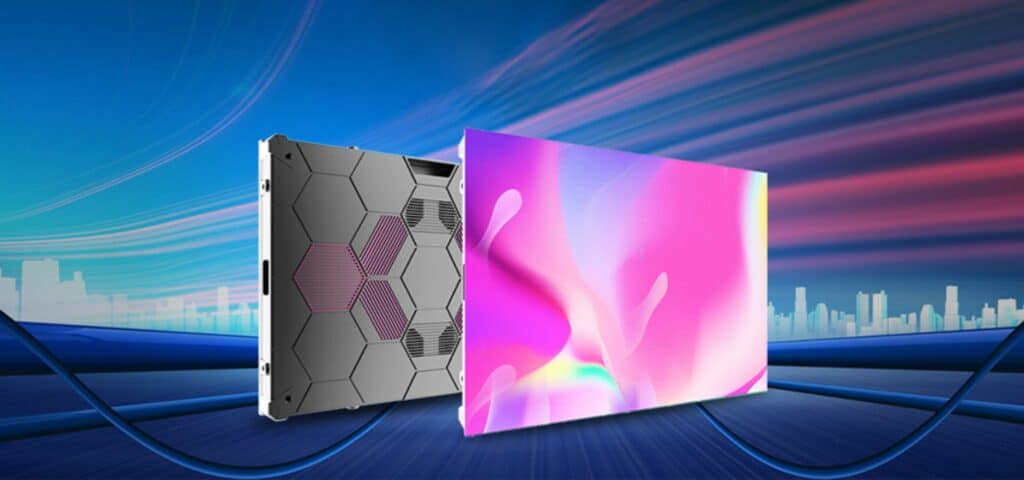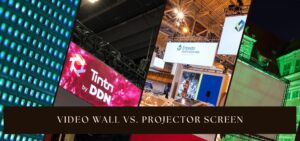
Understanding Pixel Pitch in Video Wall Displays
Pixel pitch is a crucial factor in determining the quality of video wall displays. It refers to the distance in millimeters from the center of an LED cluster, or package, to the center of the next LED packages above, below, and beside it. These LED packages are mounted on circuit boards and backplates known as modules. Those modules are tiled together to make LED cabinets — consolidated electronics units that are seamlessly tiled and stacked to form indoor or outdoor LED video walls.
Defining Pixel Pitch and Its Importance
In an LED wall, each individual LED is one pixel. The pixel pitch number indicates the distance between LEDs on the wall, which determines a recommendation of a minimum viewing distance should be to see the image as intended. The lower the pixel pitch, the closer together the LEDs are on your display, and the closer your acceptable viewing distance can be.
The optimal viewing distance is typically 2-3 times the pixel pitch number in meters. For example, a narrow pixel pitch of 2 would allow viewing from just 4 meters away, whereas a pixel pitch of 10 would require at least a distance of 20 meters to experience optimal detail. Pixel pitch affects viewing distance and LED screens’ perceived visual performance.
The Relationship Between Pixel Pitch and Display Resolution
Pixel pitch plays a significant role in determining the resolution of a display. The finer the pixel pitch is, the more light pixels are contained in each cabinet — and the smaller the physical footprint of a given resolution will be.
An LED display module with a 1.5-millimeter pitch has more pixels per module than, for example, a 4-millimeter product, so it will produce a 4K resolution of 3,840 x 2,160 pixels with much less physical space. This higher pixel density results in a higher resolution, leading to a clearer and more detailed image.
How Pixel Pitch Influences Resolution
For a given surface area, a small pixel pitch means that there will be more numbers of pixels than in a case of a larger pixel pitch. The more pixels, the higher quality, and nature of the photos displayed. A larger pixel pitch means the pixels are far isolated.
And for the same surface area, there will be fewer pixels available. A larger screen will clearly contain more pixels, whether a pixel pitch of 5mm or 10mm. So, how clear the image of your LED display will depend on the pixel pitch and your display screen size.

Pixel Pitch and Viewing Distance
The viewing distance is a critical factor when considering the pixel pitch. A direct view LED display with a super-fine 1.2-millimeter pixel pitch will look amazing to viewers when they’re just a few feet away, but if viewers are 30 feet away, their eyes won’t pick up the visual difference between a 1.2-millimeter-pitch display and a 3-millimeter-pitch version.
On the other hand, while that 3-millimeter display might look fantastic from 25-30 feet away, it wouldn’t look great if viewers saw it from much closer, as they would see each light pixel and the gaps between them.
The Ideal Viewing Distance for Various Pixel Pitches
While many variables can affect which pixel pitch would work best in a given situation, the easiest rule for determining optimal pixel pitch is to equate each millimeter in the measure of the pitch to eight feet of viewing distance.
For instance, if rows of desks facing a large seamless display in a control room or corporate briefing center are 20 feet or more from the display, then a 2.5-millimeter-pitch display would likely produce the most crisp and rich visuals. A finer pitch might look as good, but it would come at an unnecessarily higher cost. Going with a 3-millimeter or higher pitch could reduce capital costs, but it may sacrifice image quality.
Pixel Pitch and Screen Size: A Crucial Balance
The size of the screen is another important factor when considering pixel pitch. For displays suitable for close-by-distance seeing, a smaller pixel pitch is fitting. For specific applications such as billboard advertisements and the like, a larger pixel pitch is a more suitable and financially savvy choice. Observing that the survey distance isn’t the vitally fascinating point is fundamental.
You should contemplate the atmospheric conditions, without a doubt, the screen’s surface area, the image quality of your contents, your targets, and much more.
Choosing the Right Pixel Pitch for Your Screen Size
Choosing the right pixel pitch for your screen size is a delicate balance. It’s not just about the screen size but also about the viewing distance, the content to be displayed, and the overall goals of the display. For instance, LED walls with a smaller pixel pitch would be ideal in control rooms where operators need to view detailed information from a close distance. On the other hand, for digital signage applications where viewers are typically farther away, a larger pixel pitch could be a more cost-effective choice.

The Impact of Pixel Pitch on Video Wall Performance
Pixel pitch has a direct impact on the performance of a video wall. A smaller pixel pitch leads to a higher number of pixels on the screen, which results in higher resolution and better image quality. However, it’s important to note that a smaller pixel pitch also requires more LED clusters, which can increase the cost and energy consumption of the display.
Pixel Pitch and Image Quality
The image quality on a video wall is directly related to the pixel pitch. A smaller pixel pitch results in a higher pixel density, which leads to a higher resolution and a clearer, more detailed image. This is particularly important in applications where fine details need to be displayed, such as in control rooms or for high-definition video playback.
Pixel Pitch and Energy Efficiency
While smaller pixel pitches can provide higher resolution, they also require more LED clusters, which can increase the display’s energy consumption. Therefore, it’s important to consider the trade-off between image quality and energy efficiency when choosing the pixel pitch for your video wall.
Selecting the Right Pixel Pitch for Your Video Wall
Selecting the right pixel pitch for your video wall involves considering various factors, including the viewing distance, the content to be displayed, the screen size, and the display’s overall goals. By understanding these factors and how they relate to pixel pitch, you can make an informed decision that will ensure your video wall delivers the best possible performance.
Factors to Consider When Choosing Pixel Pitch
When choosing the pixel pitch for your video wall, several factors must be considered. These include the viewing distance, the size of the screen, the content to be displayed, and the overall goals of the display. Considering these factors, you can choose the pixel pitch that will best balance image quality, cost, and energy efficiency.
The Future of Pixel Pitch in Video Wall Technology
As technology advances, we can expect to see further improvements in pixel pitch technology. These advancements could lead to even smaller pixel pitches, providing even higher resolution and better image quality. However, these advancements must also balance smaller pixel pitches’ increased cost and energy consumption.





